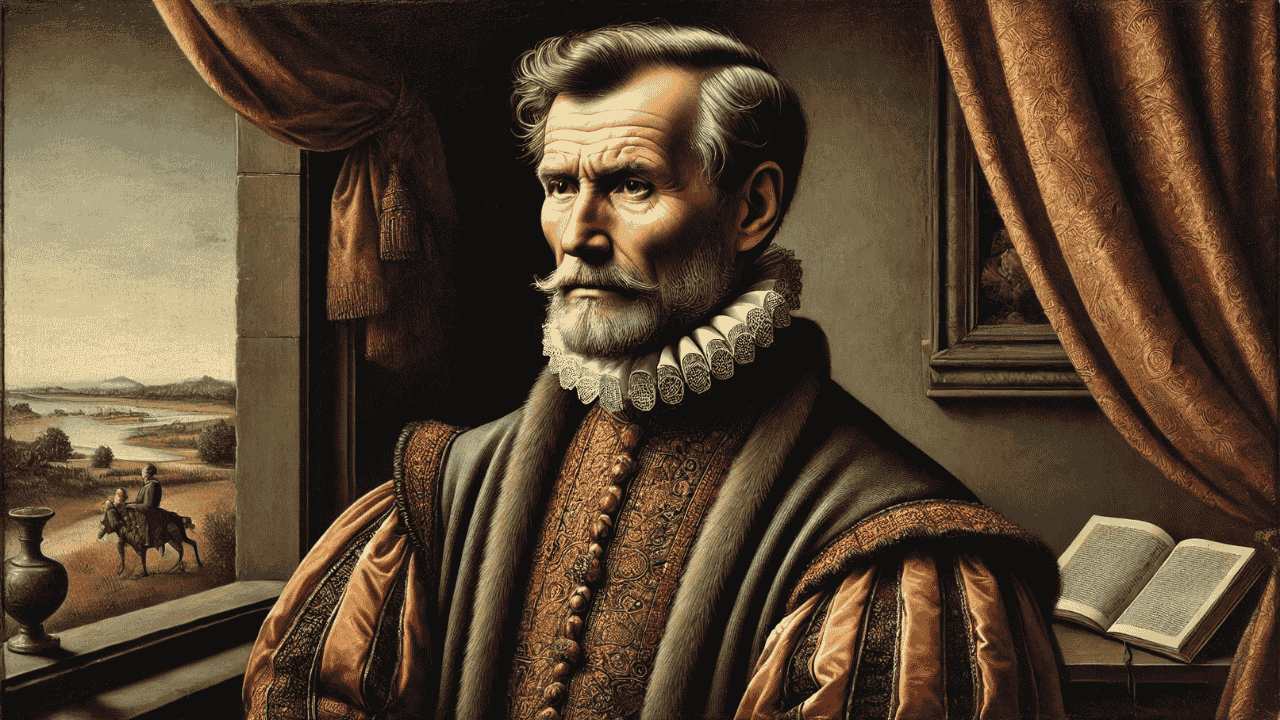The 1555 portrait of Heinrich Servais is a stunning example of Renaissance portraiture, capturing not only the likeness of a man but also reflecting the dynamic changes taking place across 16th-century Europe. At a time when art was evolving, portraits became more than just images; they were statements of identity, status, and wealth.
The Renaissance: A Time of Transformation
The Renaissance, a cultural and intellectual rebirth that lasted from the 14th to the 17th century, marked a transformative period in European history.
One of the most significant changes was the rise of individualism, a concept that was reflect in the art of the time. Artists began to focus on realistic representations of the human form, and portraiture became a vital means for individuals to assert their social identity.
In the case of the 1555 portrait of Heinrich Servais, the subject’s image is not just an artistic creation but also a powerful declaration of his position in society. The portrait mirrors the era’s growing emphasis on personal achievement and the emerging influence of the merchant class, who were beginning to rival the old aristocracy in both wealth and influence.
Heinrich Servais: A Wealthy Merchant of the Renaissance
While little is known about Heinrich Servais himself, his portrait provides important clues about his life. The portrait suggests that he was a wealthy individual, possibly a successful merchant, banker, or landowner in the Holy Roman Empire. Merchants played an increasingly important role in the economy, and their newfound wealth often led them to seek recognition and social mobility through the commission of portraits.
The 1555 portrait of Heinrich Servais, like many portraits of the period, likely served to communicate his wealth, education, and social standing. In the Renaissance, portraiture was not only a personal indulgence but also a way for individuals to assert their status publicly. For Servais, this portrait was a means of communicating his success and establishing his legacy in an increasingly competitive world.
Portraiture in the Renaissance: A Tool for Social Status
During the Renaissance, portraits became more than just artistic expressions; they were important tools for individuals to define themselves and their place within society. In an age when social mobility was limit, a well-executed portrait could be a powerful statement of one’s success. Portraits were commission by individuals who wished to showcase their accomplishments, their wealth, and their intellectual pursuits.
In the case of Heinrich Servais, the 1555 portrait likely served multiple functions. It was not only an artistic representation but also a way for him to secure his legacy. By commissioning a portrait, Servais was making a statement to his contemporaries about his achievements and importance. The practice of commissioning portraits was common among the rising merchant class, who sought to distinguish themselves from the old nobility and solidify their social standing.
The Art of Portraiture: Techniques and Innovations
Renaissance artists employed a range of techniques to create lifelike and emotionally engaging portraits. The 1555 portrait of Heinrich Servais exemplifies many of these artistic innovations, showcasing the technical prowess of the artist. Unlike the more stylized portraits of the medieval period, Renaissance artists sought to capture the true likeness of their subjects.
Realism in Renaissance Art
Realism was a key aspect of Renaissance art, and the 1555 portrait of Heinrich Servais is a prime example of this. Artists sought to depict their subjects as they truly appeared, with careful attention to detail in facial features, clothing, and posture. The portrait of Servais presents him in a naturalistic manner, with fine details that highlight the textures of his clothing and the subtle variations in his skin tone. The artist’s skill in rendering these details demonstrates the growing mastery of techniques such as shading, perspective, and proportion.
The use of realistic detail in portraiture was revolutionary. Artists moved away from the more abstract and symbolic depictions of individuals seen in earlier periods. The focus on realism during the Renaissance helped to humanize the subjects of portraits, making them more relatable and accessible to viewers.
Chiaroscuro: The Play of Light and Shadow
Another hallmark of Renaissance portraiture is the use of chiaroscuro, a technique that employs contrasts of light and dark to create a sense of depth and volume. The 1555 portrait of Heinrich Servais makes excellent use of chiaroscuro, with light highlighting the contours of Servais’ face and clothing. The play of light and shadow brings a three-dimensional quality to the image, making it appear more lifelike.
This technique not only enhances the realism of the portrait but also serves to evoke emotion and character. The soft light that falls on Servais’ face suggests calm and dignity, while the shadows add a sense of mystery and depth. The artist’s careful manipulation of light and shadow invites the viewer to engage more deeply with the subject, providing a window into his personality and character.
The Symbolic Meaning Behind the 1555 Portrait of Heinrich Servais
In addition to its technical accomplishments, the 1555 portrait of Heinrich Servais is rich in symbolism. Renaissance portraits often included subtle symbols to convey messages about the subject’s identity, achievements, and social position. In the case of Servais’ portrait, the symbolism is likely woven into his clothing, posture, and facial expression.
The Role of Clothing in Symbolizing Wealth and Status
One of the most prominent symbols in the portrait is Heinrich Servais’ clothing. During the Renaissance, the fabric, color, and style of clothing were powerful indicators of social status. Additionally. the rich textures and fine materials seen in the portrait suggest that Servais was a man of considerable wealth and influence. Clothing was a way for individuals to display their success, and the opulent fabrics in Servais’ attire indicate his position within the social hierarchy.
The specific details of Servais’ outfit—such as the lavish sleeves and collar—also suggest that he was a person of refined taste and social sophistication. In the Renaissance, an individual’s clothing was an outward reflection of their character, and artists often used clothing to underscore the subject’s identity.
Subtle Symbolism in the Expression and Posture
In addition to clothing, the posture and facial expression of the subject were important elements of Renaissance portraiture. Heinrich Servais’ calm and composed expression suggests a man of intellect and dignity. His direct gaze and confident posture communicate his self-assurance and status.
While there are no overt symbolic objects in the portrait, such as books or tools associated with specific professions, Servais’ demeanor and the precision with which he is depict convey a sense of intellectual and social authority. Additionally. his portrait is a subtle yet powerful message about his place in the world.
The Influence of the Merchant Class on Renaissance Art
The 1555 portrait of Heinrich Servais also speaks to the growing influence of the merchant class in 16th-century Europe. During this period, Europe was undergoing significant economic and social changes, with the rise of commerce and trade leading to the emergence of a wealthy middle class. Additionally. merchants, bankers, and landowners were increasingly able to commission works of art, which had traditionally been the domain of the aristocracy and the church.
The growing wealth of the merchant class allowed individuals like Heinrich Servais to participate in the cultural and intellectual life of the Renaissance. Portraits became an essential means for these individuals to project their success and social mobility. The 1555 portrait of Servais, with its emphasis on realism and individual identity, reflects this shift in artistic patronage and the changing social dynamics of the time.
The Enduring Legacy of the 1555 Portrait of Heinrich Servais
The legacy of the 1555 portrait of Heinrich Servais extends beyond its immediate historical context. As a work of art, it captures the essence of the Renaissance period, showcasing the technical achievements of Renaissance artists and the growing importance of portraiture in reflecting individual identity. The portrait continues to offer valuable insights into the changing social, economic, and cultural landscape of 16th-century Europe.
In the broader context of art history, the portrait of Heinrich Servais stands as a powerful example of Renaissance portraiture and the role it played in shaping perceptions of personal identity, wealth, and status. The rise of the merchant class and the increasing emphasis on individualism are themes that are echo in many Renaissance works, and the portrait of Servais is a testament to these transformations.
Conclusion
The 1555 portrait of Heinrich Servais goes beyond being a mere depiction of an individual; it offers a glimpse into the cultural transformations of the Renaissance.
. Through its realistic depiction, careful use of symbolism, and reflection of the values of the time, the portrait captures the spirit of an era that was define by change, progress, and the rise of individual identity. As a work of art, it continues to provide valuable insights into the social, economic, and artistic landscape of 16th-century Europe, offering a lasting legacy that speaks to the enduring power of Renaissance portraiture.
Exploring the Mathematical Significance of 11304/19.625 in Modern Business



